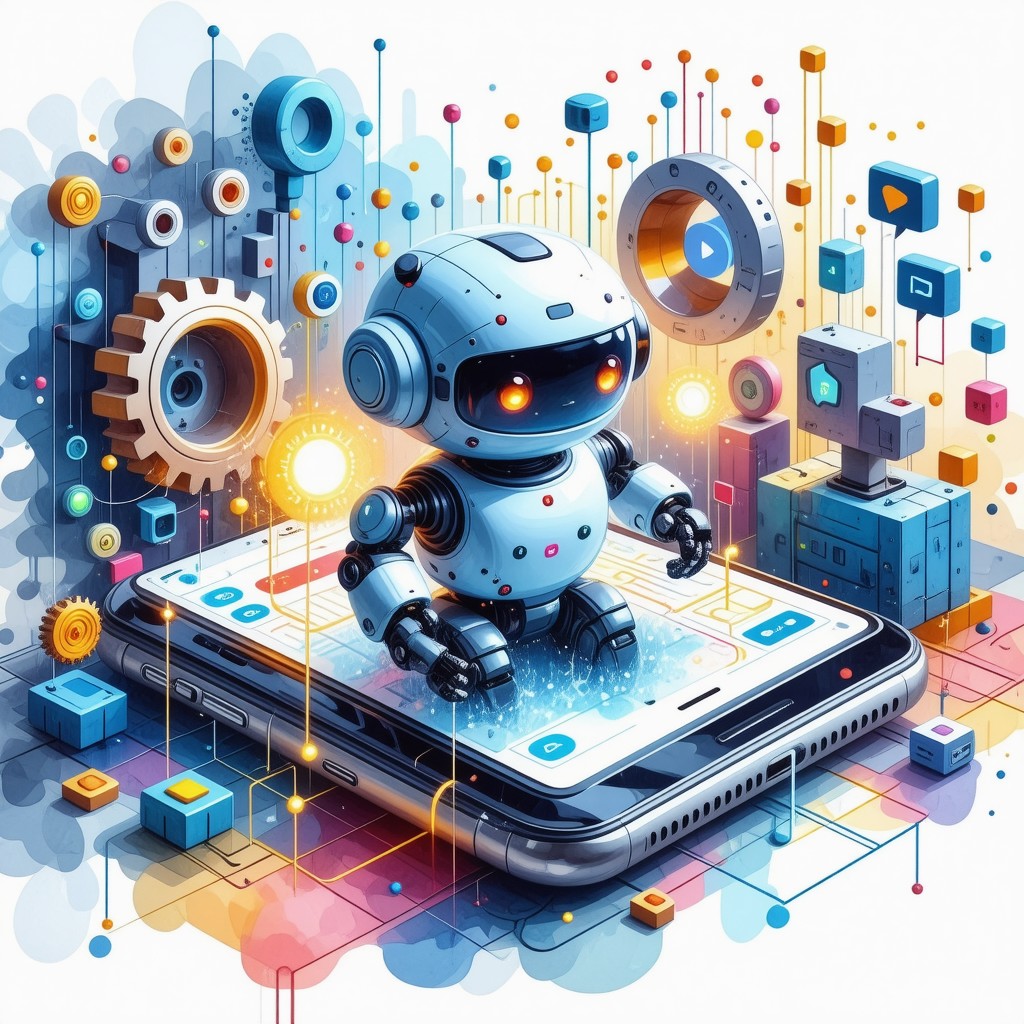In an era of digital transformation, smart chatbots are revolutionizing customer service and redefining AI-powered interactions. These intelligent virtual assistants, powered by advanced artificial intelligence and machine learning algorithms, are transforming the way businesses engage with their customers. From simple rule-based systems to sophisticated conversational AI like ChatGPT, smart chatbots have evolved to handle complex queries, provide personalized recommendations, and even learn from each interaction. This article delves into the world of smart chatbots, exploring their types, development processes, and applications across various platforms, including Android and iOS. We’ll uncover the key differences between simple and smart chatbots, examine voice-enabled assistants like Alexa, and look at how businesses can leverage free smart chatbot options to enhance their customer service strategies.
Understanding Smart Chatbots
In today’s digital landscape, smart chatbots have emerged as powerful tools for enhancing customer interactions and streamlining business operations. As a leader in AI-driven communication solutions, we at Messenger Bot understand the transformative potential of these intelligent virtual assistants. Let’s delve into the world of smart chatbots and explore their evolution.
What is a smart chatbot?
A smart chatbot, also known as an AI chatbot, is an advanced conversational interface that leverages artificial intelligence technologies to engage in human-like interactions. These chatbots utilize machine learning algorithms, natural language processing (NLP), and natural language understanding (NLU) to interpret user queries, provide contextually relevant responses, and continuously improve their performance over time.
Key features of smart chatbots include:
- Adaptive learning: They analyze past interactions to refine their responses and decision-making processes.
- Contextual understanding: Smart chatbots can comprehend the nuances of language, including idioms, sentiment, and intent.
- Multi-channel integration: They can operate seamlessly across various platforms, including websites, messaging apps, and voice assistants.
- Personalization: These chatbots can tailor their responses based on user preferences and historical data.
- Task automation: They can perform complex tasks, such as scheduling appointments, processing transactions, or troubleshooting issues.
- Emotional intelligence: Advanced chatbots can recognize and respond to human emotions, enhancing user experience.
- Multilingual support: Many smart chatbots can communicate in multiple languages, broadening their accessibility.
Smart chatbots find applications in various industries, including customer service, healthcare, finance, and education. They can handle a wide range of tasks, from answering frequently asked questions to providing personalized recommendations and assisting with complex problem-solving.
According to a report by Grand View Research, the global chatbot market size is expected to reach $1.25 billion by 2025, growing at a CAGR of 24.3% from 2019 to 2025. This growth is driven by the increasing demand for AI-powered customer support solutions and the continuous advancements in natural language processing technologies.
Evolution of AI-powered virtual assistants
The journey of AI-powered virtual assistants has been nothing short of remarkable. From simple rule-based chatbots to sophisticated AI-driven conversational agents, the evolution has been rapid and transformative. At Messenger Bot, we’ve been at the forefront of this evolution, constantly innovating to provide cutting-edge solutions.
The early chatbots of the 1960s and 1970s, like ELIZA, were based on pattern matching and predefined scripts. They could engage in basic conversations but lacked true understanding. The advent of machine learning and natural language processing in the 1990s and 2000s marked a significant leap forward. Chatbots could now learn from data and improve their responses over time.
The real game-changer came with the rise of deep learning and neural networks in the 2010s. This led to the development of more sophisticated virtual assistants like Siri, Alexa, and Google Assistant. These AI-powered assistants could understand context, perform complex tasks, and even engage in multi-turn conversations.
Today, we’re witnessing the era of conversational AI, where chatbots can understand and generate human-like text, engage in meaningful dialogues, and even exhibit creativity. Platforms like ChatGPT have pushed the boundaries of what’s possible in AI-driven conversations.
At Messenger Bot, we’re harnessing these advancements to create intelligent chatbots that can revolutionize customer service, streamline business processes, and create engaging user experiences across multiple channels. Our AI-powered virtual assistants are designed to understand user intent, provide personalized responses, and continuously learn from interactions to improve their performance.
As we look to the future, the potential for AI-powered virtual assistants is boundless. With ongoing advancements in AI and machine learning, we can expect even more intelligent, empathetic, and capable chatbots that will transform the way businesses interact with their customers and how individuals access information and services.

The Pinnacle of Chatbot Technology
As we continue to push the boundaries of artificial intelligence, the landscape of chatbot technology is evolving rapidly. At Messenger Bot, we’re constantly monitoring these advancements to ensure our platform remains at the forefront of conversational AI. Let’s explore the current state of the art in chatbot technology and highlight some of the most impressive AI-powered virtual assistants available today.
What is the smartest chatbot ever?
Determining the “smartest” chatbot is a complex task, as different AI models excel in various aspects of conversation and problem-solving. However, based on recent developments and comprehensive analyses, several chatbots stand out for their advanced capabilities:
- GPT-4: Developed by OpenAI, GPT-4 is widely regarded as one of the most advanced language models, capable of human-like conversations and complex problem-solving across a wide range of topics.
- Claude 2: Created by Anthropic, Claude 2 excels in analytical tasks and ethical reasoning, maintaining context over extended conversations.
- PaLM 2: Google’s PaLM 2 demonstrates superior multilingual capabilities and contextual understanding, making it particularly effective for global applications.
- DALL-E 3: This AI combines advanced language understanding with impressive image generation capabilities, opening up new possibilities for visual content creation.
- LaMDA: Another Google creation, LaMDA specializes in open-ended conversations with improved coherence and factual accuracy.
At Messenger Bot, we’re inspired by these advancements and continuously work to incorporate cutting-edge AI technologies into our platform. Our goal is to provide businesses with chatbot solutions that can engage in meaningful, context-aware conversations across various channels.
It’s important to note that the field of AI is rapidly evolving, and new breakthroughs are happening regularly. The “smartest” chatbot today may be surpassed by new innovations tomorrow. This dynamic landscape drives us to constantly refine and enhance our AI-powered customer service bots, ensuring that our clients always have access to the most advanced conversational AI technology.
ChatGPT: Revolutionizing conversational AI
ChatGPT, developed by OpenAI, has emerged as a game-changer in the world of conversational AI. This large language model has captured global attention due to its remarkable ability to engage in human-like conversations, understand context, and generate coherent and relevant responses across a wide range of topics.
Key features that make ChatGPT stand out include:
- Natural language understanding: ChatGPT can interpret complex queries and respond in a conversational manner.
- Contextual awareness: It maintains context throughout a conversation, allowing for more meaningful and coherent interactions.
- Task versatility: From creative writing to problem-solving, ChatGPT can handle a diverse array of tasks.
- Continuous learning: With each interaction, ChatGPT improves its responses, adapting to new information and user feedback.
The impact of ChatGPT extends beyond simple chatbot interactions. It’s being used in various industries to revolutionize customer support, assist with content creation, and even aid in coding and debugging. At Messenger Bot, we’re inspired by ChatGPT’s capabilities and are working to integrate similar advanced language models into our platform.
However, it’s crucial to note that while ChatGPT represents a significant leap forward in AI technology, it’s not without limitations. Issues such as potential biases, occasional factual inaccuracies, and the need for careful prompt engineering highlight the importance of human oversight in AI applications.
As we continue to develop our AI-powered chatbot solutions, we’re leveraging the lessons learned from ChatGPT and other advanced models to create more intelligent, context-aware, and helpful virtual assistants. Our goal is to provide businesses with chatbots that can not only answer questions but also engage in meaningful conversations, solve complex problems, and provide personalized experiences for users.
The future of conversational AI is bright, and we’re excited to be at the forefront of this revolution. By combining the power of advanced language models with our expertise in customer engagement, we’re creating chatbot solutions that are transforming the way businesses interact with their customers in the digital age.
Developing Intelligent Chatbots
At Messenger Bot, we’re passionate about pushing the boundaries of chatbot technology. We understand that creating a truly intelligent chatbot requires a blend of cutting-edge AI, meticulous planning, and a deep understanding of user needs. Let’s explore the process of developing smart chatbots and how you can leverage Python to create your own AI-powered virtual assistant.
How to make a smart chatbot?
Creating a smart chatbot is a multi-faceted process that combines artificial intelligence, natural language processing, and strategic planning. Here’s a comprehensive guide to developing an intelligent chatbot:
- Define clear objectives: Start by identifying specific goals for your chatbot and determining your target audience. This step is crucial for aligning your chatbot’s capabilities with your business objectives.
- Choose the right technology: Select an appropriate Natural Language Processing (NLP) framework such as DialogFlow, Wit.ai, or RASA. At Messenger Bot, we use advanced NLP technologies to ensure our chatbots understand and respond to user queries effectively.
- Design conversational flow: Map out user journeys and dialogue trees. Create intents, entities, and utterances to guide your chatbot’s interactions. Implementing context-awareness is key for more natural conversations.
- Develop and train the AI model: Collect and prepare training data, then utilize machine learning algorithms for intent classification and entity extraction. Continuous refinement of the model with new data and user interactions is essential for improving performance over time.
- Personalize user experience: Implement user profiling and preference tracking to tailor responses based on user history and context. Our AI-powered customer service bots use advanced personalization techniques to enhance user engagement.
- Integrate advanced AI capabilities: Incorporate natural language understanding (NLU) for better comprehension and machine learning for improved decision-making and recommendations. Consider adding speech recognition and text-to-speech for voice interactions.
- Ensure seamless integration: Connect your chatbot with relevant databases and APIs. Implement robust authentication and security measures to protect user data.
- Conduct rigorous testing: Perform extensive user acceptance testing and load testing to ensure scalability. Implement A/B testing for continuous improvement of your chatbot’s performance.
- Deploy and monitor performance: Choose appropriate deployment channels and set up analytics tools to track key performance indicators (KPIs) like user satisfaction and task completion rates.
- Continuous improvement: Regularly analyze user interactions and feedback to update intents and responses. Stay current with AI and NLP advancements to keep your chatbot at the cutting edge of technology.
At Messenger Bot, we follow these steps meticulously to ensure our chatbots deliver exceptional performance and user satisfaction. Our platform is designed to simplify this process, allowing businesses to create sophisticated chatbots without extensive technical expertise.
Python tutorials for chatbot development
Python has become the go-to language for AI and machine learning applications, including chatbot development. Its rich ecosystem of libraries and frameworks makes it an excellent choice for both beginners and experienced developers. Here are some key Python resources and tutorials to help you get started with chatbot development:
- NLTK (Natural Language Toolkit): Start with NLTK tutorials to understand the basics of natural language processing in Python. NLTK provides essential tools for working with human language data.
- TensorFlow and Keras: These powerful libraries are crucial for building and training machine learning models. Tutorials on using TensorFlow and Keras for chatbot development can help you create more sophisticated AI-driven responses.
- Rasa Framework: Rasa is an open-source machine learning framework for automated text and voice-based conversations. Their tutorials offer a comprehensive guide to building contextual AI assistants.
- Flask or Django for Web Integration: Learn how to integrate your Python-based chatbot with web applications using frameworks like Flask or Django. This is essential for deploying your chatbot on websites or web applications.
- Scikit-learn for Machine Learning: Tutorials on scikit-learn can help you implement various machine learning algorithms to enhance your chatbot’s decision-making capabilities.
At Messenger Bot, we offer comprehensive tutorials and resources to help you leverage these technologies effectively. Our platform is designed to work seamlessly with various Python libraries, allowing you to create sophisticated chatbots that can be easily integrated into your existing systems.
While Python is an excellent choice for chatbot development, it’s worth noting that other platforms like Brain Pod AI offer alternative approaches to AI-powered content creation and chatbot development. These platforms can provide valuable insights and complementary tools to enhance your chatbot development process.
Remember, creating a truly intelligent chatbot is an iterative process. It requires continuous learning, testing, and refinement. By leveraging the power of Python and staying updated with the latest advancements in AI and NLP, you can create chatbots that not only meet but exceed user expectations, providing seamless and engaging conversational experiences.
Comparing Chatbot Technologies
At Messenger Bot, we’re constantly pushing the boundaries of chatbot technology to deliver the most intelligent and efficient solutions for our clients. As we dive into the world of chatbots, it’s crucial to understand the distinctions between different types of chatbot technologies and how they impact user interactions.
What is the difference between simple chatbot and smart chatbot?
The landscape of chatbot technology is diverse, with a clear distinction between simple and smart chatbots. Understanding these differences is key to choosing the right solution for your business needs:
Simple Chatbots:
- Operate on rule-based systems with predefined responses
- Limited to specific, programmed scenarios
- Unable to understand context or nuance
- Function through pattern matching or keyword recognition
- Cannot learn or improve over time
- Best suited for straightforward, routine inquiries
Smart Chatbots:
- Powered by Artificial Intelligence (AI) and Natural Language Processing (NLP)
- Can understand and interpret natural language input
- Capable of learning from interactions and improving over time
- Able to handle complex, multi-turn conversations
- Understand context, intent, and sentiment
- Adaptable to new situations and queries
- Utilize machine learning algorithms for continuous improvement
- Can integrate with databases and external systems for comprehensive responses
- Offer personalized interactions based on user history and preferences
- Capable of handling a broader range of inquiries and tasks
At Messenger Bot, we specialize in developing smart chatbots that leverage the power of AI and NLP. Our chatbots are designed to provide a superior user experience by understanding context, learning from interactions, and delivering personalized responses. This advanced technology allows our chatbots to handle complex customer service scenarios and adapt to various business applications with ease.
The key advantage of smart chatbots lies in their ability to go beyond simple pattern matching. They can understand the nuances of human language, interpret user intent, and provide relevant, context-aware responses. This results in more natural and engaging conversations, leading to higher user satisfaction and more efficient problem-solving.
Machine learning in advanced chatbot systems
Machine learning is at the heart of what makes smart chatbots truly intelligent. It’s the technology that enables these AI-powered virtual assistants to continuously improve and adapt to new situations. Here’s how machine learning enhances chatbot capabilities:
- Natural Language Understanding (NLU): Machine learning algorithms help chatbots comprehend the intent behind user messages, even when they’re phrased in unexpected ways. This allows for more accurate and context-aware responses.
- Continuous Learning: Smart chatbots can learn from each interaction, gradually improving their responses over time. This means they become more accurate and helpful with each conversation.
- Sentiment Analysis: Machine learning enables chatbots to detect the emotional tone of user messages, allowing them to respond with appropriate empathy and adjust their communication style accordingly.
- Personalization: By analyzing user data and interaction history, machine learning algorithms can help chatbots provide personalized recommendations and tailored responses.
- Predictive Analytics: Advanced chatbots can anticipate user needs based on historical data and current context, proactively offering relevant information or assistance.
At Messenger Bot, we harness the power of machine learning to create chatbots that not only understand and respond to user queries but also evolve and improve over time. Our AI-powered customer service bots are designed to learn from every interaction, ensuring that they become increasingly effective at handling complex customer inquiries and providing valuable support.
The integration of machine learning in our chatbot systems allows for more sophisticated conversation flows, better understanding of user intent, and the ability to handle a wider range of scenarios. This results in a more natural, efficient, and satisfying user experience.
While we pride ourselves on our advanced chatbot technology, it’s worth noting that other platforms like Brain Pod AI also offer innovative AI-powered solutions. Their platform provides complementary tools that can enhance the overall AI ecosystem, demonstrating the rapid advancements in the field of conversational AI.
As we continue to innovate in the chatbot space, our focus remains on leveraging the latest advancements in machine learning and AI to create chatbots that not only meet but exceed user expectations. By combining cutting-edge technology with a deep understanding of user needs, we’re committed to delivering chatbot solutions that transform the way businesses interact with their customers, providing seamless, intelligent, and personalized experiences across all channels.

Diverse Applications of Chatbots
At Messenger Bot, we’re constantly exploring new ways to leverage chatbot technology across various industries and applications. Our AI-powered solutions are designed to meet the diverse needs of businesses, from customer service to lead generation and beyond. Let’s dive into the different types of chatbots and how they’re revolutionizing digital interactions.
What are the 4 types of chatbots?
Understanding the different types of chatbots is crucial for businesses looking to implement this technology effectively. Here’s a breakdown of the four primary types of chatbots:
- Rule-based Chatbots: These operate on predefined rules and decision trees, responding to specific keywords or commands. They’re ideal for straightforward, routine inquiries but lack the ability to understand context or complex queries. At Messenger Bot, we offer rule-based options for businesses that need simple, cost-effective solutions for handling common customer questions.
- AI-powered Chatbots: Utilizing Natural Language Processing (NLP) and Machine Learning (ML), these chatbots can understand and interpret human language, learning from interactions to improve responses over time. They’re capable of handling more complex conversations and providing personalized experiences. Our AI-powered customer service bots fall into this category, offering sophisticated, context-aware interactions that can significantly enhance customer engagement.
- Hybrid Chatbots: Combining rule-based and AI technologies, hybrid chatbots offer the reliability of pre-programmed responses with the flexibility of AI-driven understanding. This approach allows for efficient handling of common queries while still being able to adapt to more nuanced conversations. Many of our clients opt for this balanced approach, leveraging the strengths of both rule-based and AI systems.
- Voice-activated Chatbots: These chatbots use speech recognition technology to interpret and respond to voice commands. They’re increasingly popular in smart home devices and virtual assistants, offering hands-free interaction and accessibility benefits. While our primary focus is on text-based interactions, we’re exploring integrations with voice-activated systems to provide comprehensive communication solutions.
Each type of chatbot serves different purposes and offers varying levels of sophistication. At Messenger Bot, we help businesses choose the right type of chatbot based on their specific needs, industry, and target audience. Our goal is to ensure that every chatbot implementation enhances customer engagement, streamlines operations, and provides a competitive edge in the digital marketplace.
Smart chatbot apps for Android and iOS
The mobile app landscape has seen a surge in smart chatbot applications, catering to both Android and iOS users. These apps leverage the power of AI and machine learning to provide intelligent, on-the-go assistance. Here’s an overview of how smart chatbot apps are making waves on mobile platforms:
Features of Smart Chatbot Apps:
- Natural Language Understanding: Advanced apps can interpret user intent and context, even in casual conversation.
- Personalization: Many apps learn from user interactions to provide tailored responses and recommendations.
- Multi-platform Integration: The best chatbot apps seamlessly sync across devices and platforms, ensuring consistent user experiences.
- Voice Recognition: Some apps incorporate voice commands, allowing for hands-free operation.
- Task Automation: From scheduling appointments to setting reminders, these apps can handle a variety of tasks.
At Messenger Bot, we’ve developed our mobile solutions to be compatible with both Android and iOS devices, ensuring that businesses can reach their customers on their preferred platforms. Our feature-rich chatbot platform is designed to work seamlessly across desktop and mobile interfaces, providing a consistent and engaging user experience.
For businesses looking to implement smart chatbot apps, it’s crucial to consider factors such as user interface design, performance optimization, and integration with existing systems. Our team at Messenger Bot specializes in creating custom chatbot solutions that not only meet these technical requirements but also align with your brand identity and business goals.
While we focus on providing top-tier chatbot solutions, it’s worth noting that other platforms like Brain Pod AI also offer innovative AI-powered tools that can complement chatbot functionalities. Their platform provides additional AI services that can enhance the overall capabilities of your digital ecosystem.
As the mobile app market continues to evolve, we’re committed to staying at the forefront of chatbot technology. Our ongoing research and development efforts ensure that our clients have access to the most advanced and effective chatbot solutions for their mobile strategies. Whether you’re looking to improve customer service, boost engagement, or streamline operations, our smart chatbot apps are designed to deliver results across both Android and iOS platforms.
Voice-Enabled Virtual Assistants
At Messenger Bot, we’re constantly exploring the evolving landscape of AI-powered communication tools. While our focus is on developing sophisticated chatbot solutions, we recognize the importance of understanding the broader spectrum of virtual assistants, including voice-enabled technologies. Let’s delve into how these different AI applications compare and complement each other in the digital ecosystem.
Is chatbot like Alexa?
While chatbots and voice-activated assistants like Alexa share some similarities in their use of AI and natural language processing, they serve distinct purposes and have unique characteristics:
- Purpose and Scope: Our chatbots at Messenger Bot are primarily designed for business-specific tasks and customer service interactions. They excel in handling inquiries, providing support, and guiding users through predefined processes. In contrast, Alexa, developed by Amazon, is a more generalized virtual assistant aimed at personal use, capable of a wide range of tasks from setting reminders to controlling smart home devices.
- Interaction Method: The chatbots we develop are predominantly text-based, operating through messaging platforms, websites, or mobile apps. Alexa, on the other hand, is voice-activated, requiring users to speak commands to a physical device like the Amazon Echo.
- Customization and Learning: Our AI-powered chatbots can be highly customized for specific business needs and can learn from interactions to improve responses over time. Alexa’s learning capabilities are more broad-based, adapting to individual user preferences across various domains.
- Integration: While our chatbots integrate seamlessly with various business systems and platforms, Alexa’s integration capabilities extend to a vast ecosystem of smart home devices and third-party services.
Understanding these differences is crucial for businesses deciding on the most effective AI solution for their needs. At Messenger Bot, we focus on creating chatbots that offer targeted, efficient, and scalable solutions for business communication and customer service.
Personal assistants vs. chatbots
The distinction between personal assistants and chatbots is important to understand when considering AI solutions for your business:
Personal Assistants:
- Designed for individual use and personal task management
- Offer a wide range of functionalities across various aspects of daily life
- Often voice-activated and integrated with smart home systems
- Examples include Alexa, Siri, and Google Assistant
Chatbots:
- Focused on specific business functions or customer service roles
- Typically text-based, operating through messaging platforms or websites
- Designed to handle specific types of queries or tasks within a defined scope
- Can be customized to align closely with a brand’s voice and business processes
At Messenger Bot, we specialize in developing chatbots that bridge the gap between personal assistants and traditional customer service channels. Our AI-powered customer service bots offer personalized interactions within a business context, providing efficient, scalable support that enhances customer experience while aligning with your brand’s unique needs.
While personal assistants like Alexa excel in managing individual users’ daily tasks, our chatbots are engineered to handle complex business interactions, from lead generation to customer support. They can be integrated into your existing digital infrastructure, offering a seamless extension of your customer service team.
For businesses looking to explore more comprehensive AI solutions, platforms like Brain Pod AI offer additional tools that can complement chatbot functionalities, such as AI writing assistants and image generation capabilities. These can be valuable for creating content that supports your chatbot’s interactions or enhancing your overall digital presence.
As we continue to innovate in the field of AI-powered communication, our goal at Messenger Bot is to provide businesses with chatbot solutions that offer the best of both worlds: the efficiency and scalability of automated systems, combined with the personalized touch of human-like interactions. By focusing on business-specific applications, we ensure that our chatbots deliver tangible value, improving customer engagement and operational efficiency across various industries.
The Future of AI-Powered Customer Interactions
At Messenger Bot, we’re constantly innovating to stay at the forefront of AI-powered customer interactions. As we look towards the future, we see a landscape rich with opportunities for businesses to enhance their customer engagement strategies through advanced chatbot technologies. Let’s explore some key developments and how they’re shaping the future of customer service.
Smart chatbot free options for businesses
We understand that businesses of all sizes are looking to leverage AI-powered chatbots to improve their customer service. That’s why we offer a range of solutions, including free options to get started with smart chatbots:
- Free Trial: Our free trial offer allows businesses to experience the power of our AI-driven chatbots without any initial investment. This gives you the opportunity to see firsthand how our technology can transform your customer interactions.
- Basic Features: Even with our free options, you get access to core functionalities like automated responses, basic lead generation, and integration with popular messaging platforms.
- Customization: We provide tools that allow you to tailor your chatbot’s responses to align with your brand voice, ensuring a consistent customer experience.
- Scalability: As your needs grow, our platform is designed to scale with you, offering seamless upgrades to more advanced features and capabilities.
While we pride ourselves on offering robust free options, it’s worth noting that competitors like MobileMonkey and ManyChat also provide free tiers for businesses looking to explore chatbot technology. However, our focus on AI-powered solutions and seamless integration sets us apart in the market.
Integrating chatbots with existing customer service platforms
The future of customer service lies in the seamless integration of AI chatbots with existing platforms. At Messenger Bot, we’re dedicated to making this integration as smooth as possible:
- Omnichannel Support: Our chatbots are designed to work across multiple channels, including social media, websites, and messaging apps, providing a consistent experience regardless of where customers choose to interact.
- CRM Integration: We offer integration capabilities with popular CRM systems, allowing for a unified view of customer interactions and enabling more personalized service.
- Analytics and Reporting: Our platform provides detailed insights into chatbot performance, helping businesses continually refine their customer service strategies.
- Human Handoff: We’ve developed sophisticated algorithms that can recognize when a conversation needs to be transferred to a human agent, ensuring complex issues are handled appropriately.
As we look to the future, we’re excited about the potential of AI to further enhance these integrations. For instance, Salesforce has been pioneering AI-driven CRM integrations, and we’re working on similar advancements to ensure our chatbots can provide even more value within existing business ecosystems.
The integration of AI chatbots with customer service platforms is not just about efficiency; it’s about creating a more responsive, personalized, and effective customer experience. By leveraging our AI-powered customer service bots, businesses can elevate their support experience, providing round-the-clock assistance that adapts to customer needs in real-time.
As we continue to innovate, we’re also exploring partnerships with platforms like Brain Pod AI, which offers complementary AI services such as content generation and image creation. These collaborations could open up new possibilities for creating rich, interactive chatbot experiences that go beyond text-based interactions.
The future of AI-powered customer interactions is bright, and at Messenger Bot, we’re committed to leading the charge. Whether you’re a small business just starting out or a large enterprise looking to revolutionize your customer service, we have the tools and expertise to help you succeed in this exciting new landscape of AI-driven customer engagement.




